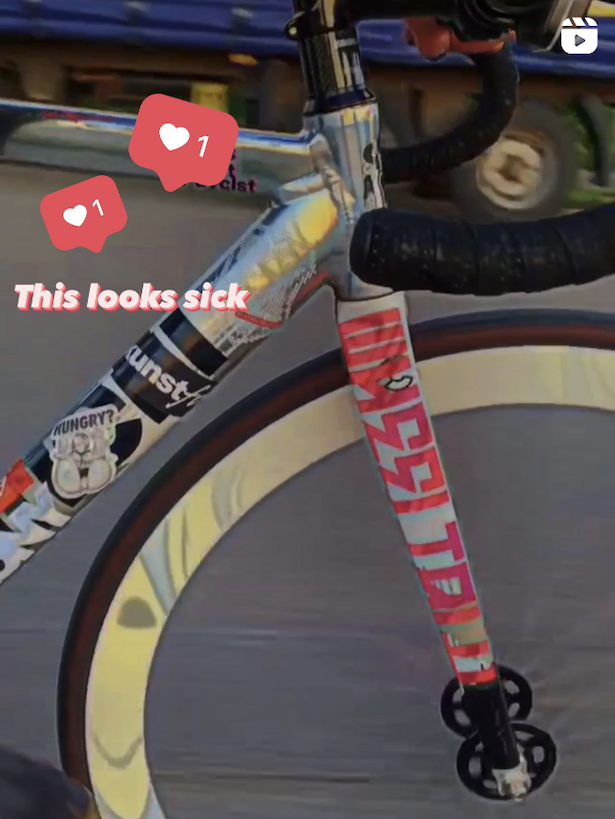
So you’re in the garage, looking at that red can of WD-40, then at your bike chain. Should you? Shouldn’t you? The internet’s screaming conflicting advice, your buddy swears by it, and that bike shop guy looked at you like you suggested putting ketchup on a steak.
This debate cuts across all cycling, but the stakes change depending on what you ride.
TL;DR
- WD-40 is a solvent first, lubricant second – Great for cleaning chains, questionable as your main lube
- Use it strategically – Clean with WD-40, then apply real chain lube for best results
- Budget vs performance trade-off – WD-40 works but requires constant maintenance
What’s Actually in WD-40 (The Science Part)
Look, I’m not gonna pretend this is the most exciting topic, but knowing what you’re spraying matters.
| Component | What It Does | Your Chain’s Take |
|---|---|---|
| Low vapor pressure aliphatic hydrocarbon (45-50%) | Main solvent/penetrant | Cleans well, lubricates… lightly |
| Petroleum base oil (<35%) | Some lubrication | Better than nothing |
| Other aliphatic hydrocarbons (<25%) | More solvents | Keeps cleaning |
| Carbon Dioxide (2-3%) | Spray propellant | Just gets it out the can |
Source: WD-40 Company official safety data sheets
Plot twist—it’s mostly solvent. That “lubrication” you feel? It’s there, but it’s not the star of the show.
The Case Against WD-40 (Why Mechanics Cringe)
Walk into any bike shop and mention using WD-40 as chain lube. Watch their face. Here’s their reasoning:
It’s a degreaser first, lubricant second. Remember those solvents? They’ll strip whatever good lube was already on your chain. So you might actually make things worse.
Bike chains need real protection. That constant pedaling motion means metal-on-metal contact under load. WD-40’s light film might not provide adequate protection.
Weather is your enemy. Cycling means getting caught in downpours. WD-40 washes off fast, leaving you with a squeaky, unprotected chain exactly when you need lubrication most.
I’ve seen chains that looked like they’d been through a blender after months of WD-40-only treatment. Not pretty.
But Wait—Some People Swear By It
Here’s where it gets weird. I know riders who’ve used nothing but WD-40 for years. Their chains look fine, they’re not replacing them constantly, and they’ll argue with you about it.
Dry conditions are WD-40’s friend. If you’re riding in dusty, dry climates, heavier lubes attract grime like crazy. WD-40’s light consistency means less buildup.
Maintenance frequency matters. The riders who succeed with WD-40 are usually the ones cleaning and re-lubing constantly. Like, obsessively.
Budget reality. Good chain lube costs 2-3x more than WD-40. If you’re stretching dollars, I get it.
The Product Breakdown (What You’re Actually Buying)
| Product | Type | Best For | Fixed Gear Reality Check | Cost |
|---|---|---|---|---|
| WD-40 Original | Penetrating oil/cleaner | Cleaning, emergency lube | Risky as main lube | $5-7 |
| WD-40 Bike Chain (Dry) | Actual bike lube | Dry/dusty conditions | Actually decent | $9-13 |
| WD-40 Bike Chain (Wet) | Actual bike lube | Rain/humidity | Works fine | $9-13 |
| Quality bike chain oil | Purpose-built | Everything | Your chain will thank you | $8-16 |
Prices vary, obviously
When WD-40 Makes Sense (The Nuanced Take)
For cleaning? Absolutely. WD-40 cuts through old, gunky chain lube better than almost anything. Spray it on, let it sit, wipe clean. Just don’t stop there.
Emergency situations? Sure. Caught in the rain with a squeaky chain and no bike shop in sight? WD-40 will get you home. Just plan to do it right later.
As your only chain maintenance? Probably not. Unless you’re that obsessive maintenance person who enjoys cleaning chains twice a week.
Maintenance Reality
Most of us aren’t bike mechanics. We want something that works without constant fussing. Here’s what actually happens with different approaches:
WD-40 only: Clean your chain every 100-150 miles, reapply constantly, expect more frequent chain replacement. Works if you’re diligent.
Proper chain lube: Clean and lube every 200-300 miles depending on conditions, chains last longer, better performance in bad weather.
Mixed approach: Use WD-40 for deep cleaning, follow with real chain lube. Best of both worlds but more work.
Why Fixed Gear Chains Are Different (And Why It Matters)
Your chain doesn’t get to take breaks. While road bike chains shift around, distributing wear across different gear combinations, your fixed gear chain sits in the same spot. Always. It handles every single pedal stroke, every skid stop, every time you resist a downhill by backpedaling.
That constant tension? It’s not just a vibe—it’s physics. Your chain’s working overtime compared to a bike with derailleurs.
Most of us are also city riders. Stop lights, debris, puddles, that mystery gunk that somehow appears on bike paths. Our chains see it all.
What I’d Actually Recommend
For most cyclists? Get real chain lube. Here’s why it’s worth the extra few bucks:
- Finish Line Dry Lube if you’re in dry, dusty areas
- White Lightning Clean Ride if you hate cleaning chains
- Phil Wood Tenacious Oil if you want to lube once and forget about it
But if you’re gonna use WD-40 anyway (and let’s be honest, some of you will), here’s how to do it less badly:
- Use it to clean your chain thoroughly
- Wipe everything clean with a rag
- Apply a proper chain lube afterward
- Don’t use WD-40 as your regular maintenance routine
Common Questions (Without the Q&A Format)
People always ask if WD-40 damages chains. Not directly—it’s not acid or anything. But using it as your only maintenance will probably shorten chain life through inadequate lubrication.
How often to reapply? If you’re using it as lube (against my advice), you’ll be reapplying constantly. After every wet ride, every 50-75 miles in dry conditions.
Track vs street use makes a difference too. Track bikes in controlled environments can get away with more minimal lubrication. Street fixed gears deal with everything the city throws at them.
The WD-40 bike-specific lubes are actually fine. They’re formulated differently than the original stuff and work like proper chain lubes should.
FAQ
Does WD-40 actually damage my chain? Not directly, but using it as your only maintenance will probably shorten chain life through inadequate lubrication. Think of it like using hand lotion as engine oil—won’t explode, but not ideal.
How often do I need to reapply WD-40 if I use it as lube? Constantly. After every wet ride, every 50-75 miles in dry conditions. You’ll be carrying that red can everywhere.
Can I use WD-40 to clean my chain then switch to real lube? Yes, this actually works great. WD-40 cuts through old gunk better than most cleaners. Just wipe it clean first.
What about track bikes vs street fixed gears? Track bikes in controlled environments can get away with lighter lubrication. Street bikes deal with rain, dirt, and city grime—they need stronger protection.
Are WD-40’s bike-specific lubes any good? Yeah, they’re actually fine. Formulated differently than the original red can and work like proper chain lubes should.
Will mixing WD-40 with other lubes mess things up? WD-40’s solvents can break down other lubricants. If switching products, clean your chain completely first.
My buddy uses only WD-40 and his chain looks fine – what gives? Some people make it work through obsessive maintenance. If he’s cleaning and relubing constantly, it can work. Most of us aren’t that dedicated.
What’s the cheapest alternative that’s better than WD-40? 3-in-1 oil has better viscosity, or hunt for sales on proper bike chain lube. Sometimes the bike-specific stuff isn’t much more expensive.
How do I know when my chain needs better than WD-40? Squeaking during pedaling, visible rust, if you’re riding more than casual distances, or poor performance in wet conditions.
The Bottom Line
WD-40 has its place. That place is cleaning your chain and emergency situations, not as your daily driver chain lube.
Your bike chain works hard and deserves protection that matches that workload. The few extra dollars for proper chain lube will save you money on chain replacement and make your rides smoother.
But if budget’s tight or you’re already committed to the WD-40 life, just be realistic about maintenance frequency. Your chain will need more attention, not less.
Pick what works for your riding style, budget, and how much you enjoy bike maintenance. Just don’t expect miracles from a $6 can of penetrating oil.





























